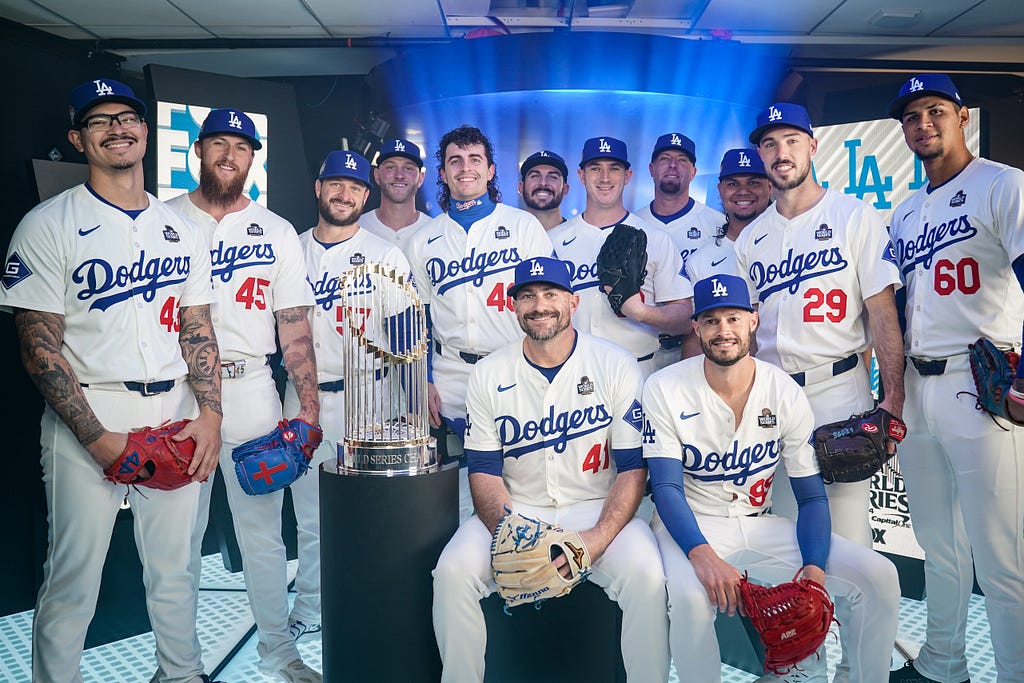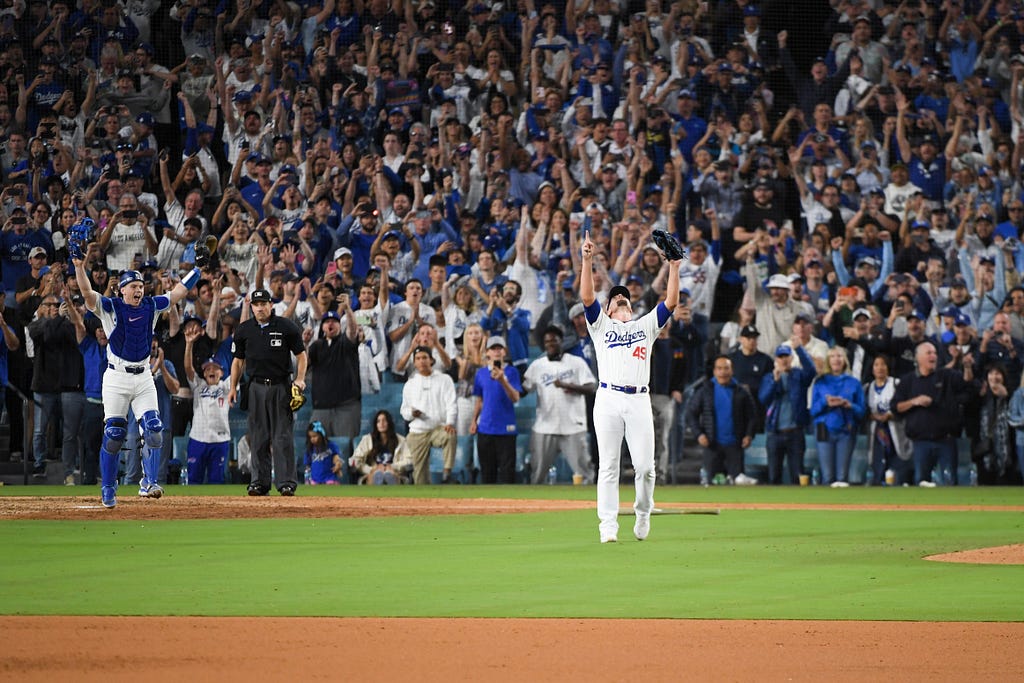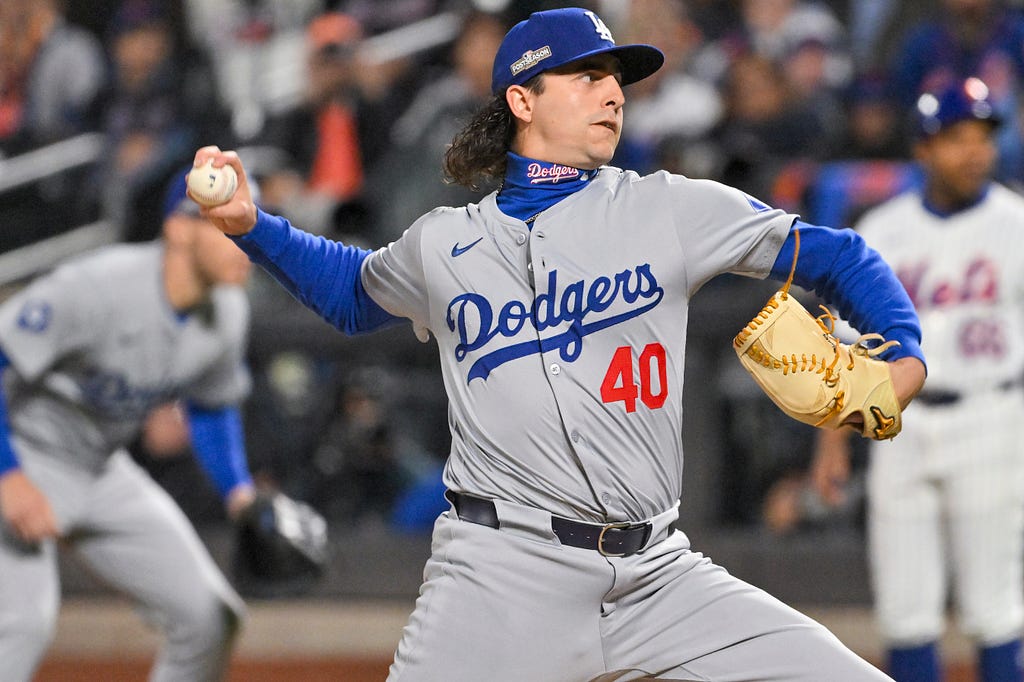
by Cary Osborne
At a point during the season, the lights went dark, the bullpen gate swung open and a Dodger reliever began to jog onto the field.
Not too far in the distance, Dodger reliever Brusdar Graterol started to bark.
“We were kind of looking at him like, ‘What the heck?’” said Dodger reliever Alex Vesia. “And we kind of just fed off of that, and it grew more and more. We’ve embraced that. Day in and day out, we’ve been calling ourselves dogs because that’s what you have to be when you’re in the bullpen.”
So it’s not so much of a bullpen but a kennel. And the Dodger dogs — a group of veterans, rookies (this postseason) and eccentric personalities have collectively helped lift the Dodgers at the most important time of the season.
But the bullpen blueprint — from a philosophical standpoint — is laid out long before October.
It’s laid out in February.
The last few Dodger Spring Trainings have usually begun with manager Dave Roberts being asked: Who is the Dodgers closer?
And typically, Roberts wouldn’t commit.
Though, this year, he was closer to declaring that it was Evan Phillips.
And Phillips wore the fireman captain’s hat at the end of games for most of the season. But he also pitched in the sixth, seventh and eighth innings.
Fourteen different Dodgers earned a save this season.
Roles were defined — but it simply made more sense to define those roles for the game and for the matchup rather than the traditional closer, set-up man, lefty specialist, etc.
And thus, the Dodger bullpen was prepared for the postseason.
“Traditionally, you might see a bit more structured layout for a bullpen,” Phillips says. “We’ve had situations throughout the season where we’ve had guys that needed to pitch in different situations just based on availability — starters’ health, things like that, relievers health. And we’ve had our own bit of injuries this year as well. So for each guy to just kind of learn to roll in different scenarios throughout the season has been huge for how we’re being used right now.”
Phillips is the latest injury. He has appeared in five postseason games, but is off the World Series roster. He experienced tightness in Game 6 of the NLCS and hasn’t rebounded to the point where the Dodgers feel comfortable putting him on the World Series roster. It’s a big blow, considering he hasn’t allowed a run in the postseason and has typically entered games to bridge the middle innings when the Dodgers have had a lead.
But Graterol, who was not on the National League Division Series or the NL Championship roster is on the World Series roster.
He appeared in just seven games in the regular season due to a shoulder injury a season after leading the NL in reliever ERA.
But the Dodgers managed to thrive without him for most of the season and the first two rounds of the postseason.

The flexibility of the pitchers who make up the bullpen — and many of them having pitched in high-leverage situations is one reason the unit was able to be successful. But the personalities help explain another part.
“We’re all confident going in with the ability to just get the ball to the next guy,” said reliever Michael Kopech. “It has been huge. We’ve rallied around that the entire postseason.”
Kopech is part of a group of pitchers who weren’t part of the original blueprint — which started with the idea that Phillips and veterans Daniel Hudson, Blake Treinen, Ryan Brasier and Joe Kelly would form a high-leverage gauntlet for opposing teams with one left-hander to neutralize other teams’ lefties in Alex Vesia. (But Vesia emerged as an equally good reliever against lefties and righties, thus giving the Dodgers the ability to deploy him at any point this season.)
Kopech was acquired from the White Sox in the middle of their historic dreadful season at the trade deadline. At the time, he saved nine of Chicago’s 27 wins. But he had a 4.74 ERA.
He had a 1.13 ERA for the Dodgers in 24 games after the trade and has allowed one run in six appearances this postseason.
“He came in and dropped right into our bullpen. That was a very tight-knit group, those guys,” said Dodger pitching coach Mark Prior. “And so I think it’s also just kind of a situation where you go out and you have a chance to win every day things can things get a little bit brighter.”
Left-hander Anthony Banda was the first in-season addition. Vesia, at the time, was the only left-handed pitcher of the group. Banda was acquired from Cleveland on May 17 in one of those quiet transactions — he was traded for cash considerations.
Banda added one of the best swing-and-miss sliders in the Majors to the Dodgers — a 51.3% whiff rate. He has allowed one run is six postseason appearances.
“It just says a lot of it says a lot about the front office and scouts and everything about this organization and what they do. They see the talent in the individuals, and they know what they’re going after, and they know how to exploit those talents,” Banda said. “They understand the characteristics of us humans, and understanding that each individual player has very unique characteristics. It’s just like plug and play with the lanes that they put us in, and they understand that we’re not going to shy away from any big moment or anything else like that.”
Thus the reason that one of the Dodgers’ best tactics in the postseason has been the bullpen game.
It’s been used three times — a win in Game 4 of the NLDS (nine shutout innings), a loss Game 2 of the NLDS (seven runs allowed) and the NLCS-clinching Game 6 win (five runs allowed).
Along the line in the NLCS, a different breed of dog emerged.

Brent Honeywell — the once top-pitching prospect in the Rays organization who had four elbow surgeries and was designated for assignment twice this year, including once by the Dodgers.
The right-hander walks to the mound to ’80s rocker Billy Squier’s “The Stroke.” He permed his hair in the postseason. He walked onto the team bus in New York one day wearing a black sweater-gold chain combo that’s a riff on the cringe-worthy photo of The Rock before he broke it big. Honeywell is one of two pitchers in the big leagues who throws a screwball.
Honeywell twice saved the bullpen in NLCS losses, helping to preserve arms for the next day’s win. Max Muncy said it was Honeywell’s 4 1/3 innings in NLCS Game 5, where he wore it from the Mets but kept giving the Dodgers innings, put the team in position to win Game 6.
After the Game 6 win, with the Dodgers pouring champagne onto each other and celebrating, Honeywell lamented how he didn’t like his performance — that he caught too much of the plate. Then he looked at the big picture and said it was not about me, but about we.
Then he laid out the picture of the bullpen and why and how it works. There are more dogs and together, they are a pack.
“We’ve got (bullpen coach) Josh Bard in there. We’ve got (bullpen catchers) ‘Hammer’ (Hamlet Marte) and ‘Chico’ (Francisco Herrera) in there. We couldn’t do it without any of those three guys,” Honeywell said. “It’s a different kind of baseball anywhere. And I love it because winning the game comes first. Nothing else. Win the game! Do whatever you have to do to win the game!”
World Series: The Dodger relievers’ pack mentality was originally published in Dodger Insider on Medium, where people are continuing the conversation by highlighting and responding to this story.